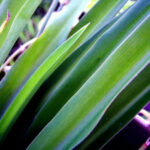Shade is not only useful in cooling the house in summer and in providing a pleasant place to sit outdoors, but it also produces micro-climatic situations that may be helpful in growing other plants. At times shade may be less desirable and prevent the use of curtain plants, or eliminate gardening activities, that require abundant sunlight. Therefore, as we develop the landscape around our homes, we must constantly plant with shade in mind. We must be aware of the daily and seasonal shift in shade patterns with the movement of the sun as well as the increase in shaded areas as plants grow and develop.
While the shade of shrubs influences smaller plants growing near them, the shade from trees dominates the home landscape. It provides aesthetic beauty as the patterns fall upon lawns, structures, and other plants around the home. One of the most useful qualities of trees around the home is temperature control. Large to medium sized shade trees planted to the south and southwest of the home are most functional in providing summer shade on the side and roof of the house.
Normally, largo shade trees should not be planted closer than 20 feet from the home, and only the strong-wooded types should be used for such close planting. Remember, when locating trees, that the angle of the sun shifts from about 26 degrees above the horizon in winter to about 73 degrees above the horizon in summer. When deciduous trees are used, the long shade patterns produced in winter are generally not much of a problem. However, when tall evergreen trees, such as pines, are used on the south side, they may provide too much winter shade.
The shade does not allow interior heating from the sun, or delays the melting of ice or snow on walks and driveways that may be close by. Shade patterns from trees and structures can he both dense and light, and thereby influence nearby plantings. Dense shade falls in acorn with its base, or widest part, closest to the tree. It is the area which never receives any direct sunlight. The lightly shaded area also forms a somewhat conical pattern, but the narrowest portion of the cone is closest to the tree. This is the area of shifting shade where some direct sunlight is received at some time during the day.
Many vegetables, annual flowers, and perennial flowers need six or more hours of full sunlight each day to flower and produce well. The outer areas of such a shifting shade pattern may be useful for these plantings, but close to the center of the shade pattern only plants that are shade tolerant may be used. Shade from buildings is most dense, while the shade from trees varies with the size of leaves and density of branching. When large trees are located between the living area and a flower planting, flowers often face away from the area in which they are to be viewed.
Many flowering plants will develop with their blooms facing toward the brightest light. When planting flowers in shade, use impatiens or begonias that are shade tolerant. Light colors and white flowers show best in shaded areas. If you are unsure of the shade patterns in your landscape, place a few tall stakes where trees might be planted. These can help you project lines of shade, and help determine the shifting patterns as you observe their shadows throughout the year.
http://www.northscaping.com/Tools/LG/LandscapingGuideCh10.shtml






